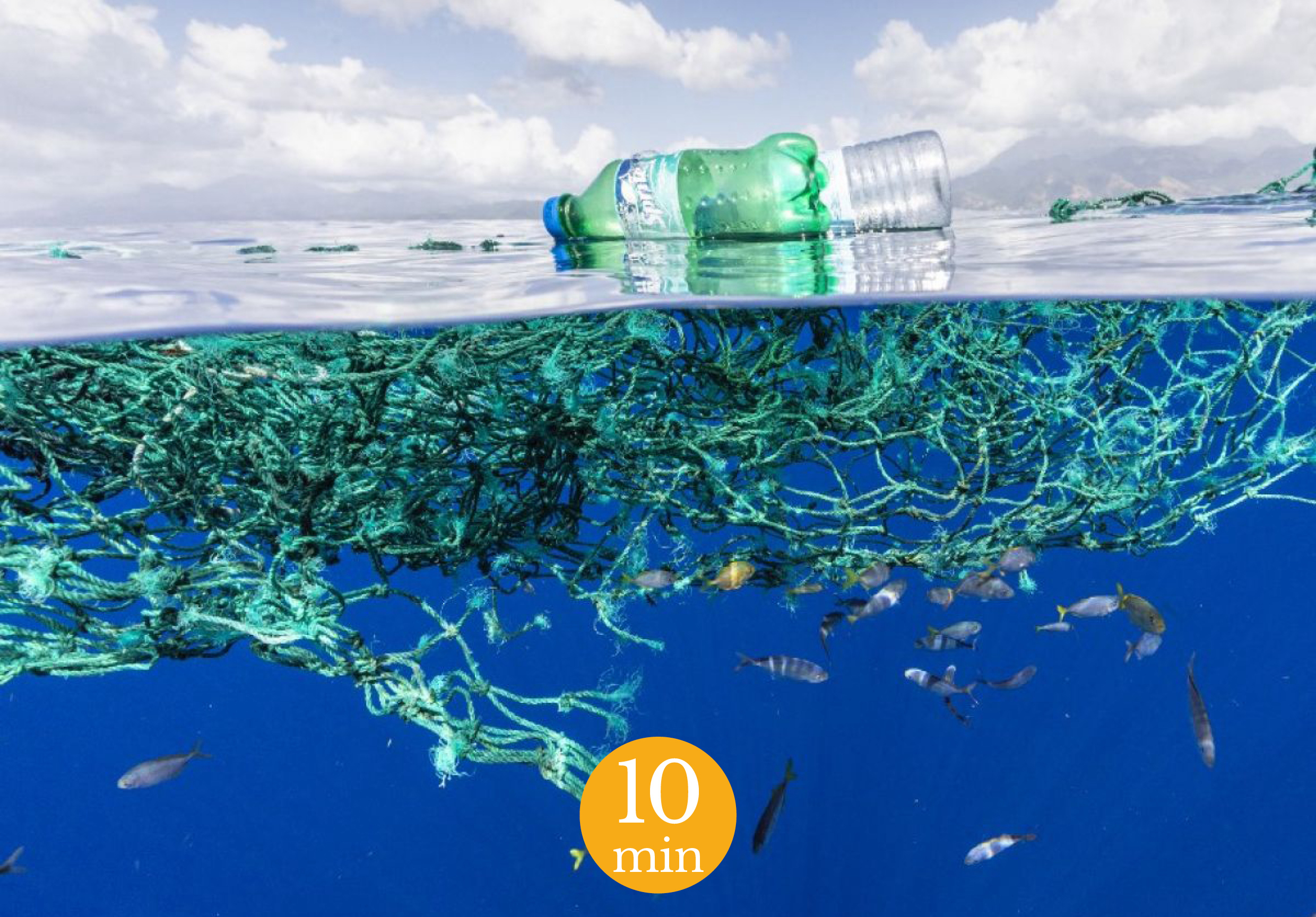"A sea of islands" is how Fijian-Tongian writer and anthropologist Epeli Hau'ofa describes the Pacific Ocean, a vast expanse of water whose peoples know and use the transport routes. Contrary to a vision of islands isolated from each other, Hau'ofa seeks to show the unity of the Oceanian peoples within the Pacific Ocean. But in 1997, American oceanographer Charles J. Moore was astonished to come across a relatively new, scattered island in the North Pacific1, which today equals to 3 times the size of mainland France. An immense island, both on the surface and on the seabed, mainly constituted of... plastic.
The presence of plastic in rivers, seas and oceans is no longer a mystery. The environmental impact of plastic waste can be seen in the often-heart-breaking photographs of turtles with their heads trapped in plastic packaging, marine mammals washed up on beaches, trapped in fishing nets, and dead seabirds with a multitude of plastic objects in their bellies. Marine litter is defined by the United Nations Environment Program as "any persistent solid material, manufactured or processed, discarded, disposed of or abandoned in the marine and coastal environment, the dispersion and concentration of which in the marine environment is now internationally recognised as a problem".2 However, awareness does not necessarily lead to action, especially in an area such as the ocean, where currents and the absence of borders often make it impossible to define who is responsible and who will take the decisions. What's more, the nature of this "plastic soup" - a more illustrative term than "continent" to represent an expanse of waste on the surface and at depth, scattered, mobile and inhabited by a variety of species - makes it impossible to clean up this waste without endangering an ecosystem. Then, what do we do?
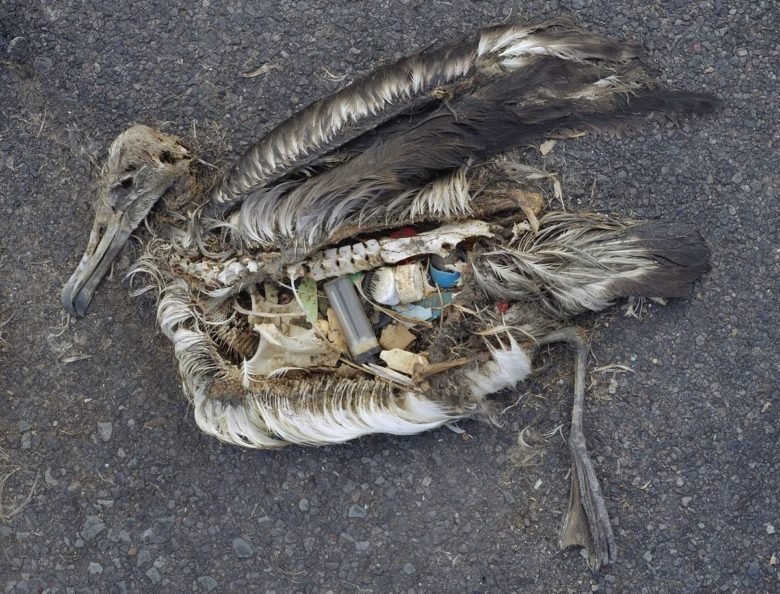
Albatros found dead on a beach in the Midway islands (North Pacific), his belly is full of plastics. Chris Jordan, September 2009 © Chris Jordan. CC BY 2.0
The source of the problem is not in the ocean itself. It can often be thousands of kilometres away. Between 4 and 12 million tons of plastic waste3 are thrown into oceans and land every year. 80% ends up in the oceans as a result of poor land-based waste management: containers that are too full, 'wild' open dumps in countries that have no recycling infrastructure. The remaining 20% is due to activities at sea, in particular lost or abandoned fishing nets4, or microplastics that have fallen off cargo ships.
Plastic was born in the 19th century in the West with the advent of industrial society. Without going into detail about its composition, in 1933 polyethylene was created and became the most widely used plastic today. For example, it is used to make bags and bottles. From 1945, plastic was made from petroleum.5 We use these materials on a daily basis, and many of them are intended for a single use, as containers. You only have to look at the proportional quantity of plastic and the quantity of food or other goods brought home when you go shopping in the supermarket to realise the problem.
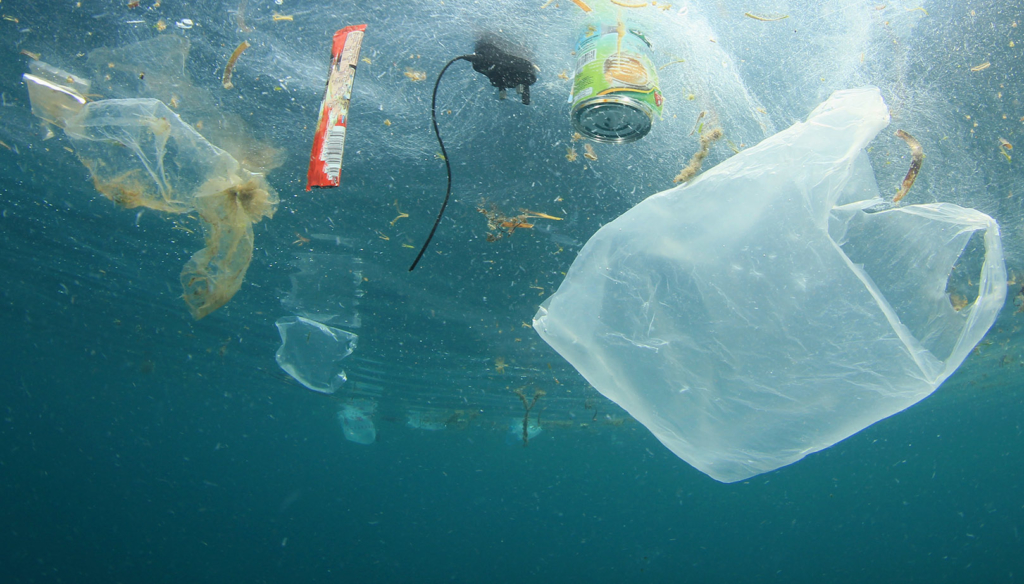
Oceans pollution, European Union ©AP Images.European Union-EP
The Pacific Ocean has two gyres or "plastic soups", one in the north and the other in the south, but there are also gyres in the Atlantic Ocean, the Indian Ocean and the Mediterranean Sea. In these eddies created by currents, plastic waste accumulates and breaks down into tiny particles under the action of ultraviolet rays, the force of currents and salt. Today, these gyres could contain around 6kg of plastic for just 1kg of plankton!6 At the base of the food chain, plankton is eaten by small animals, which in turn are eaten by carnivorous fish, the latter sometimes eaten by humans. As members of the food chain, we are no exception to the ingestion of Persistent Organic Pollutants (POPs), which are produced by the combustion of plastics or found in pesticides. Once in the water, plastic attracts these pollutants and concentrates them. Through bioaccumulation and their resistance, the concentration of POPs multiplies and their quantity increases throughout the food chain. A further problem is that the persistence of these pollutants means that they can be transmitted from a woman to her fetus, affecting its development.7
Reading this, you might think that the impact of microplastics on our health no longer needs to be proven. However, a few weeks ago, in June 2023, fifteen French representatives had a strand of their hair tested for eternal pollutants8, particularly those contained in plastic products, in order to draw attention to their toxicity. Similar example, Emily Penn, a yachtswoman, suspected she had been exposed to POPs and had herself tested for 35 of them, banned by the United Nations due to their toxicity. 29 were found in her blood. Following these alarming results, in 2014 she co-founded the non-profit organisation eXXpedition with biologist Lucy Gilliam.9 The aim is to conduct participatory scientific expeditions, including a circumnavigation of the globe divided into 30 sections (or legs). The all-female crew is made up of members of all ages and nationalities, committed to observing and raising awareness of the presence of plastic and its impact on the environment and marine ecosystems.
"By applying the same collection and study protocol to the data collected on the 30 legs of the round-the-world trip, eXXpedition aims to determine and compare the quantity of plastic in the oceans, the type of polymers present and the ways in which currents affect their circulation".10

Map of the initial circumnavigation, from October 2019 to September 2020. It was stopped by covid-19 epidemic, in April 2020. © EXXpedition
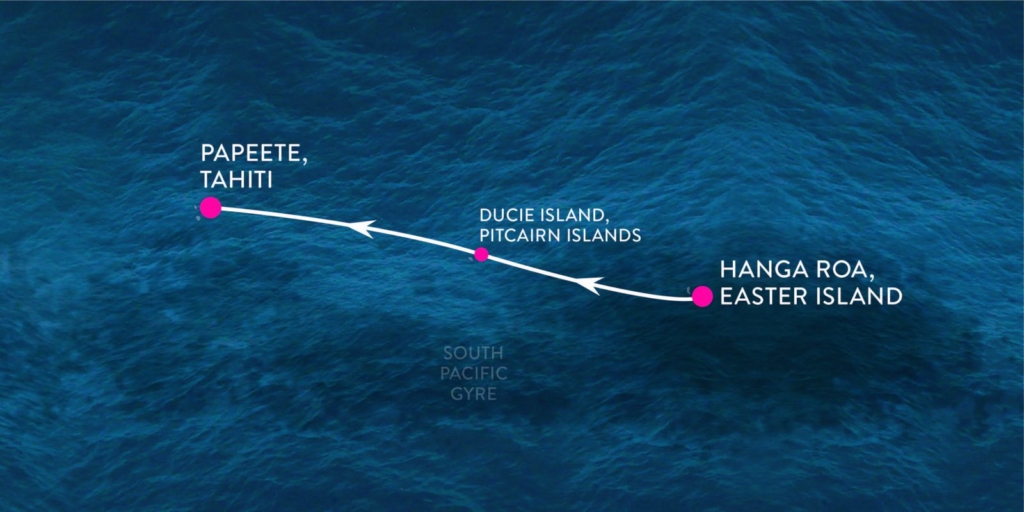
Leg 8 of the expedition travelled from Rapa Nui (Easter Island) to Tahiti between March and April 2020 © EXXpédition
In March 2020, at the 8th "leg", the expedition crossed part of the South Pacific gyre. This stage of the expedition is narrated by anthropologist Géraldine Le Roux, a member of the crew11 in Sea Sisters. Un équipage féminin à l'épreuve de la pollution dans le Pacifique. (A women's crew put to the test of pollution in the Pacific).12 Richly illustrated with photographs of the voyage, this book reads like a logbook, full of human adventures and rich in scientific and anthropological information. Using a vocabulary that is clear and accessible to all, the author presents the problems associated with plastic pollution, describing and explaining each stage of collection and scientific survey. These data are punctuated by chapters in which she recounts the stories, comments and initiatives of Pacific populations in facing this issue. Reading the book, you almost feel like part of the crew, with their excitement at the start, their despair at the environmental findings, or their perception of a global covid-19 pandemic from a sailing boat in the middle of the ocean. For Géraldine Le Roux, participatory or citizen science is a way of bringing together people from all walks of life and scientists to collect and process data, but above all to disseminate it and raise awareness through stories and concrete examples of the battle being waged. Like many experts, eXXpedition's watchword regarding such an environmental disaster is "turn off the tap".
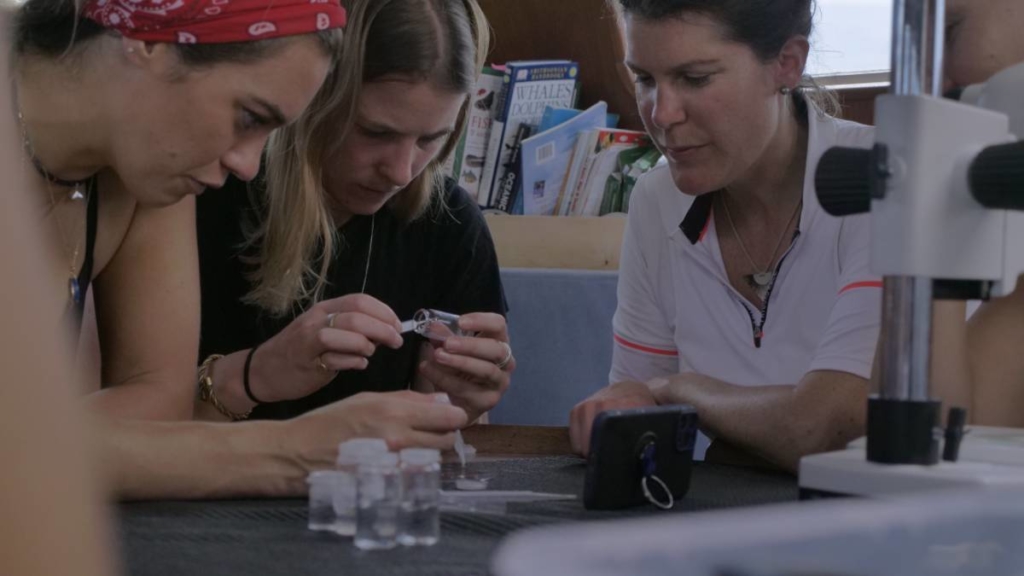
Sorting the plastic samples collected during leg 8 of eXXpeddition. Rachel Lucas / EXXpeddition
"When there's a flood in your house, you first turn off the tap, then you mop it up. The logic is the same for plastic: now that we know the damage it causes, we need to reduce its production as much as possible".13
This injunction to reduce plastic production is not so evident to put into practice. Firstly, there are real inequalities when it comes to plastic pollution. Some countries do not have the infrastructure needed to deal with the mass of plastics on their territory. This is the case for most of the Pacific islands. With the gradual importation of Western consumer habits, the islands are faced with an increasingly urgent need to manage this waste. On some islands, such as Rapa Nui and Hawai’i, frenetic tourism does nothing to help the situation, as it increases the number of consumer products arriving in all kinds of packaging, which is then left behind. While the Pacific islands are overrun with plastic waste coming from oceans, this alarming quantity does not correspond to the actual consumption of its inhabitants. The region contributes just 1.3% of global plastic pollution and produces no plastic polymers.14 The plastic debris on the coasts arrive by sea and pile up on the beaches, sometimes surpassing the quantity of algae and living organisms. In fact, globally, high-income countries produce 47% of plastic, emerging countries 35% and low-income countries only 17%. 15
The actors involved in plastic pollution in the Pacific Ocean are therefore international in scale. The difficulty then arises in getting this multiplicity of actors, with their potentially contradictory wishes and interests, to talk to each other. "Economic issues, with the expansion of multinational companies - particularly extractive industries - industrial fishing and development issues for island countries; environmental issues, with the protection of biodiversity and the fight against global warming; political and sovereignty issues, with geopolitical competition between various imperialisms and the maritime assertiveness of island countries".16 In 1982, the Montego Bay Convention on the Law of the Sea created Exclusive Economic Zones (EEZs), whose resources are managed by coastal states, but where traffic remains free. Outside these zones, maritime areas are not subject to any national jurisdiction; they are known as the high seas. Representing 60% of the planet's surface area, the high seas are a source of conflicts of interest, between the monopolisation and sharing of certain areas and their resources, with economic issues often taking precedence. These conflicts were illustrated recently during the week of negotiations for an international treaty to put an end to plastic pollution, held at the UN between April and June 2023. Following several days of discussions between representatives of 175 countries, consensus on the issue of plastic production is difficult to reach. The interests of certain countries in the oil industry are delaying or diminishing the initial ambitions of this summit. China alone accounts for 32% of global plastic production.17 Apart from these countries, industries and firms are playing a role in blocking concrete action. Coca-Cola, which in 2021 was ranked by the NGO Break Free From Plastic as the biggest generator of plastic waste in the environment,18 stopped distributing glass bottles in the Polynesian islands of Samoa that same year for economic reasons, replacing them with plastic bottles.19 They are just one example of companies playing a major role in plastic production, as decision-makers that act beyond national regulations, leaving countries with little or no resources to manage a growing mass of plastic debris in a way which is considered by some authors as “waste colonialism”.20

Coca-Cola plastic bottles pollution. © Thomas Castelazo
In many ways, Pacific islands are being invaded by waste that is not theirs, or that is unwanted. In 2019, for example, the Samoan Islands decided to organise a plastic-free Pacific Games and sought solutions to reduce the presence of plastic and its single use during the event as much as possible. Alternatives to plastic bags already exist in many Pacific territories: bilum21 in Vanuatu and New-Guinea, or woven baskets in Samoa.
Since 2010, the Maori non-profit organisation Para Kora has been working to promote zero waste, working with 450 Maori communities and organisations. Through an education program called Oranga Taiao, it adapts to the issues faced by each community by using Maori principles and concepts.22 The establishment of Marine Protected Areas (MPAs) can also be a solution for preserving ecosystems. On Rapa Nui, the Motu Morito Hiva Marine Park not only protects marine diversity, but also gives the island's populations the opportunity to access and manage resources. By favouring traditional and local fishing, local jobs are preserved and there is a reduction in the number of gigantic industrial fishing nets washed up on beaches or lost in the open sea. 23
Taking into account and implementing traditional forms of resource management can also provide solutions. In French Polynesia for example, rahui consists of designating a temporarily sacred place and restricting access to it: it becomes tapu, which means sacred, forbidden. Once used by Polynesians to preserve and enable the reproduction of marine species, today it is also used to control fishing from time to time and to help preserving the environment. Beyond the environmental issue, it "involves a community of which the gods and ancestors as well as future generations are an integral part".24 For Pacific peoples, the ocean is a multitude of paths linking people together, often created by the first gods, and forming a territory to which the people themselves belong. In a way, the ocean has the same capacity for agency and identity as any human being, and is not solely a reservoir from which to extract natural resources. Various communities see themselves as responsible, in the sense that they are in charge of preserving this nature. Vernacular knowledge linked to the preservation of nature is more and more in the spotlight, as anthropologist Barbara Glowczewski points out with regard to the knowledge of Aboriginal populations on fire management in Australia.25 As far as the oceans are concerned, the knowledge and traditions of the people of the Pacific geared towards environmental sustainability already exist and have been operational for generations. But they are often invisible in the legal frameworks specific to the West, established with the arrival of settlers in the region. It is necessary to reconcile scientific vocabulary and principles with vernacular conceptions and practices in the relationship with and preservation of nature.
In this respect, let us take up the words and proposals of Epeli Hau'ofa, mentioned in the introduction of this article. When he talks about the sovereignty of the peoples of the Pacific, it is not a question of the appropriation of a maritime space or control over its resources. "Unlike a sovereignty delimited by state borders established through western legal regimes or the genealogical descent of particular Indigenous peoples and their communities, Hau'ofa's new paradigm of a supplemental and alternative sovereignty is fundamentally relational and Oceanian. ‘Oceania refers to a world of people connected to each other'.”26 For Epeli Hau'ofa, the primary role of all Pacific people, regardless of their origins, would be to be its guardians and protectors. He invites us to consider the ocean and, more generally, nature as an actor, not just as a subject but as a partner. For some, giving the ocean rights and a legal personality – as was the case in 2017 for Te Awa Tupuna (the Whanganui River) in Atearoa27 – would raise awareness of the need to protect it and of the impact of plastic waste on its biodiversity.
Margaux Chataigner
Cover picture : Ghost nets, fishing nets and plastic bottles floatting on the sea . © FRANCO BANFI / BIOSPHOTO / BIOSPHOTO VIA AFP in https://www.sciencesetavenir.fr/nature-environnement/pollution/plastiques-biosources-et-biodegradables-pas-si-ecologiques-que-ca_171443, last accessed on 03 July 2023.
1 TERRACOL, M., 2022. « Continent de plastique : qu’est-ce que le vortex de déchets du Pacifique nord ? » in GEO, https://www.geo.fr/environnement/definition-vortex-ou-tourbillon-de-dechets-du-pacifique-nord-great-pacific-garbage-patch-124624, last accessed on 03 July 2023.
2 LE ROUX, G., 2022. L’art des ghostnets : approche anthropologique et esthétique des filets-fantômes. Paris, Musée national d’Histoire naturelle, p. 30.
3 Ibid., p. 29.
4 For more informations regarding fishing nets or ghost nets, you can read the following article: SPIGOLON, E., 7 juin 2018. « L’art aborigène contre les filets fantômes : interview de Stéphane Jacob sur les sculptures Ghostnets », in CASOAR, disponible here. For more insights on oceanian artists's answers to climate change and oceans pollution, you can read: NYSSEN, G., 29 juillet 2020. « Bouleversements environnementaux et changement climatique dans les arts contemporains océaniens », in CASOAR, disponible here.
5 ARTE., 2020. « La planète malade du plastique » in Le Dessous des Cartes, émission du 22/08/2020, 13 minutes. https://www.arte.tv/fr/videos/091146-011-A/le-dessous-des-cartes/, last accessed on 3rd July 2023. To go further on this topic, see MONSAINGEON, B., 2017. Homo Detritus. Paris: éditions du Seuil.
6 LE ROUX, G., 2021. Sea Sisters. Un équipage féminin à l’épreuve de la pollution dans le Pacifique. Bouzigues, Indigène éditions, p. 31.
7 Ibid., p. 58.
8 Those are extremely toxic and extremely persistent chemical compounds. For more informations : MANDARD, S., HOREL, S., juin 2023. « Les ‘polluants éternels’ sont partout, même dans les cheveux des députés », in Le Monde, https://www.lemonde.fr/planete/article/2023/06/28/pfas-les-polluants-eternels-sont-partout-meme-dans-les-cheveux-des-deputes_6179525_3244.html, last accessd on 03 July 2023.
9 The double capital "X" in the word underlines the feminine character of the project, through the representation of chromosomes.
10 « En appliquant un même protocole de collecte et d’étude aux relevés réalisés sur les 30 étapes du tour du monde, eXXpedition a comme objectif de déterminer et comparer la quantité de plastique dans les océans, le type de polymères présents et la façon dont les courants affectent leur circulation ». LE ROUX, G., 2021. Sea Sisters. Un équipage féminin à l’épreuve de la pollution dans le Pacifique. Bouzigues, Indigène éditions, p. 32.
11 Géraldine Le Roux is a senior lecturer and co-director of the ethnology department at the Université de Bretagne occidentale. She is particularly interested in the art of the Ghostnets, an artistic practice found particularly in the Pacific, which consists of recycling fishing nets into sculptures or artistic objects.
12 This book forms the basis of this article. It's a mine of information and a funny, touching story that I can only recommend you read, whatever your initial knowledge of the subject!
13 Translated from: « Lorsque vous avez une inondation chez vous, vous allez d’abord fermer le robinet, puis vous épongez. La logique est la même pour le plastique : maintenant que l’on sait les dégâts qu’il cause, il faut réduire autant que possible sa production ». LE ROUX, G., 2021. Sea Sisters. Un équipage féminin à l’épreuve de la pollution dans le Pacifique. Bouzigues, Indigène éditions, p. 52.
14 FULLER, S., NGATA, T., BORRELLE, S., FARRELLY, T., 2022. “Plastic pollution as waste colonialism in Te Moananui” in Journal of Political Ecology, n° 29(1), p. 542.
15 ARTE., 2020. « La planète malade du plastique » in Le Dessous des Cartes, émission du 22/08/2020, 13 minutes. https://www.arte.tv/fr/videos/091146-011-A/le-dessous-des-cartes/, last accessed on 03 July 2023.
16 Translated from: « Enjeux économiques, avec l’expansion des firmes multinationales – en particulier extractives –, la pêche industrielle et les questions de développement des pays insulaires ; enjeux environnementaux de protection de la biodiversité et de lutte contre le réchauffement climatique ; enjeux politiques et de souveraineté, avec la compétition géopolitique entre impérialismes variés et l’affirmation maritime des pays insulaires ». LE MEUR, P-Y., BAMBRIDGE, T., DEGREMONT, M., RODARY, E., 2018. « Les espaces marins du Pacifique entre logiques de commun et d’accaparement » in Revue Internationale des Etudes du Développement, Paris, éditions de la Sorbonne, n° 234, p. 11.
17 HAZIZA, E., juin 2023. « Pollution plastique : le sommet mondial à Paris, une étape cruciale vers un traité international » in Un degré de conscience, émission diffusée sur Franceinfo, https://www.francetvinfo.fr/replay-radio/un-degre-de-conscience/pollution-plastique-le-sommet-mondial-a-paris-une-etape-cruciale-vers-un-traite-international_5837240.html, last accessed on 03 July 2023.
18 Those datas are the result of plastic waste collects by volunteers around the world. MANDARD, S., 2021. « Coca-Cola, champion du monde de la pollution plastique » in Le Monde, https://www.lemonde.fr/planete/article/2021/10/25/coca-cola-champion-du-monde-de-la-pollution-plastique_6099763_3244.html, last accessed on 03 July 2023.
19 ARTE., 2021. « Coca-cola, leader pollueur », in Les infos clés, posté le 02/08/2022, 3 minutes. https://www.facebook.com/watch/?v=3231496720422330
20 FULLER, S., NGATA, T., BORRELLE, S., FARRELLY, T., 2022. “Plastic pollution as waste colonialism in Te Moananui” in Journal of Political Ecology, n° 29(1), p. 548.
21 For more informations about Bilum n see: MARTIN, M., 10 novembre 2021. « Les Bilum de Nouvelle-Guinée : sacs en ficelle et énergie créatrice féminine », in CASOAR, disponible here.
22 FULLER, S., NGATA, T., BORRELLE, S., FARRELLY, T., 2022. “Plastic pollution as waste colonialism in Te Moananui” in Journal of Political Ecology, n° 29(1), p. 552.
23 LE ROUX, G., 2021. Sea Sisters. Un équipage féminin à l’épreuve de la pollution dans le Pacifique. Bouzigues, Indigène éditions, p. 22.
24 LE MEUR, P-Y., BAMBRIDGE, T., DEGREMONT, M., RODARY, E., 2018. « Les espaces marins du Pacifique entre logiques de commun et d’accaparement » in Revue Internationale des Etudes du Développement, Paris, éditions de la Sorbonne, n° 234, p. 15.
25 GLOWCZEWSKI, B., 2020. « Réimaginer la terre avec les peuples autochtones », in BELLIER, I., HAYES, J., (eds.), A propos des échelles de gouvernance et droits des peuples autochtones, revue en ligne Terrestres, n° 12. https://www.terrestres.org/2020/03/10/reimaginer-la-terre-avec-les-peuples-autochtones/, last accessed on 03 July 2023.
26 BAMBRIDGE, T., ARCY (d’), P., MAWYER, A., 2021. “Oceanian Sovereignty : rethinking conservation in a sea of islands” in Pacific conservation Biology, n° 27, p. 348.
27 PATTÉE, E., mars 2017. « Enquête. Nouvelle-Zélande : les droits et devoirs du fleuve Whanganui », in Libération, https://www.liberation.fr/debats/2017/03/28/nouvelle-zelande-les-droits-et-devoirs-du-fleuve-whanganui_1558950/, last accessed on 03 July 2023.
Bibliography:
- ARTE., 2020. « La planète malade du plastique » in Le Dessous des Cartes, émission du 22/08/2020, 13 minutes. https://www.arte.tv/fr/videos/091146-011-A/le-dessous-des-cartes/, last accessed on 03 July 2023.
- ARTE., 2021. « Coca-cola, leader pollueur », in Les infos clés, posté le 02/08/2022, 3 minutes. https://www.facebook.com/watch/?v=3231496720422330, last accessed on 03 July 2023.
- BAMBRIDGE, T., ARCY (d’), P., MAWYER, A., 2021. “Oceanian Sovereignty : rethinking conservation in a sea of islands” in Pacific conservation Biology, n° 27, pp. 345-353.
- BRADY, C., 2016. Trashed. Film documentaire, 1h30 minutes.
- EXXpedition, disponible à l’URL : https://exxpedition.com/expedition/round-the-world/, last accessed on 03 July 2023.
- FULLER, S., NGATA, T., BORRELLE, S., FARRELLY, T., 2022. “Plastic pollution as waste colonialism in Te Moananui” in Journal of Political Ecology, n° 29(1), pp. 534-560.
- GLOWCZEWSKI, B., 2020. « Réimaginer la terre avec les peuples autochtones », in BELLIER, I., HAYES, J., (eds.), A propos des échelles de gouvernance et droits des peuples autochtones, revue en ligne Terrestres, n° 12. https://www.terrestres.org/2020/03/10/reimaginer-la-terre-avec-les-peuples-autochtones/, last accessed on 03 July 2023.
- HAZIZA, E., juin 2023. « Pollution plastique : le sommet mondial à Paris, une étape cruciale vers un traité international » in Un degré de conscience, émission diffusée sur Franceinfo, https://www.francetvinfo.fr/replay-radio/un-degre-de-conscience/pollution-plastique-le-sommet-mondial-a-paris-une-etape-cruciale-vers-un-traite-international_5837240.html, last accessed on 03 July 2023.
- LE MEUR, P-Y., BAMBRIDGE, T., DEGREMONT, M., RODARY, E., 2018. « Les espaces marins du Pacifique entre logiques de commun et d’accaparement » in Revue Internationale des Etudes du Développement, Paris, éditions de la Sorbonne, n° 234, pp. 9-30.
- LE ROUX, G., 2021. Sea Sisters. Un équipage féminin à l’épreuve de la pollution dans le Pacifique. Bouzigues, Indigène éditions.
- LE ROUX, G., 2022. L’art des ghostnets : approche anthropologique et esthétique des filets-fantômes. Paris, Musée national d’Histoire naturelle.
- MANDARD, S., 2021. « Coca-Cola, champion du monde de la pollution plastique » in Le Monde, https://www.lemonde.fr/planete/article/2021/10/25/coca-cola-champion-du-monde-de-la-pollution-plastique_6099763_3244.html, last accessed on 03 July 2023.
- MANDARD, S., HOREL, S., juin 2023. « Les ‘polluants éternels’ sont partout, même dans les cheveux des députés », in Le Monde, https://www.lemonde.fr/planete/article/2023/06/28/pfas-les-polluants-eternels-sont-partout-meme-dans-les-cheveux-des-deputes_6179525_3244.html, last accessed on 03 July 2023.
- PATTÉE, E., mars 2017. « Enquête. Nouvelle-Zélande : les droits et devoirs du fleuve Whanganui », in Libération, https://www.liberation.fr/debats/2017/03/28/nouvelle-zelande-les-droits-et-devoirs-du-fleuve-whanganui_1558950/, last accessed on 03 July 2023.
- TERRACOL, M., 2022. « Continent de plastique : qu’est-ce que le vortex de déchets du Pacifique nord ? » in GEO, https://www.geo.fr/environnement/definition-vortex-ou-tourbillon-de-dechets-du-pacifique-nord-great-pacific-garbage-patch-124624, last accessed on 03 July 2023.
